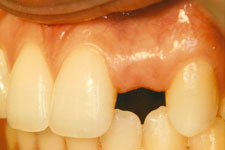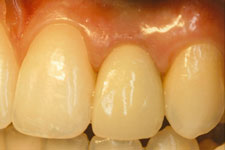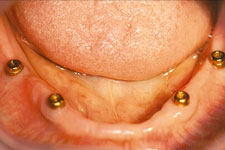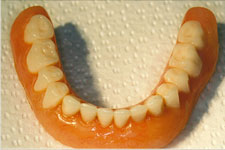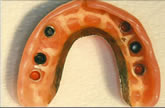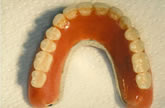Day or night for
24/7 access
7:30 AM to 4:30 PM
Monday through Friday
Our commitment is to excellence in dental implants, one patient at a time
Periodontists concentrate on maintaining the health of gingival tissues and bone surrounding teeth. Since dental implants are fixtures placed into bone, periodontists were very comfortable with the emerging technology of placing dental implants, and also being involved with the maintenance and treatment of implant-related situations. We have been placing dental implants in our practice since 1987 - and even after placing thousands of dental implants, we continue to follow all the patients we have helped. If you are in implant therapy with us, we will follow your progress closely throughout the entire time your implant is integrating into your bone. And we will want to see you after your final restoration to make sure your implant is as healthy as possible, and so that we can take a radiograph to serve as a baseline against which we can compare future radiographic images. Your restoring dentist will take future radiographs and send them to us for review. Then we'll send your dentist a report on how well the bone levels are maintaining around your implant. When you have chosen to have dental implants placed in our office, we want to make sure that you have long term success.
You will never have to be without "teeth"
Over the past two decades, not only have the implants themselves changed, but there are now techniques to place the improved implants safely, routinely and successfully in areas where it previously might not have been possible. We have also dramatically shortened the time between implant placement and final restoration. But most importantly, you never have to be without teeth, as we can either place a temporary provisional crown or bridge, or give you a temporary removable replacement to use while your implant is connecting to your bone. This is one area of dentistry that has truly made great strides in both patient comfort and convenience.
|
||
|
Replacing a Missing Tooth
A natural tooth is anchored into the jawbone by its tooth root. Tooth roots attach firmly to the jawbone and keep your teeth stable when chewing solid foods.
In the past, if you were missing a tooth or if one needed to be extracted, the healthy teeth on either side of the missing tooth would be cut down and the whole thing replaced with a three-crown "bridge".Dental implants are the modern alternative. Instead of cutting down two perfectly healthy teeth, we insert a dental implant to replace your missing tooth root. This post becomes solidly fixed into your jaw (like a natural tooth root). Your general dentist then places a crown onto this artificial tooth root that looks, feels, and functions like your natural teeth.
Quite simply, dental implants are the most natural replacement for missing teeth.
Replacing Several Teeth
When there are several teeth missing, there used to be only three options:
- Cutting down the teeth on each side of each missing tooth, and then connecting them all with a fixed bridge - but fixed bridges can only span so far before their strength and longevity is compromised.
- Using teeth on each side of the missing teeth to support the clasps of a removable partial denture - but longer partial dentures mean that there might be more coverage of the roof of your mouth, and more problems with retention.
- Leave the teeth unreplaced - but this can lead to problems with speech and difficulties chewing.
With the new implants, now we can give you and your dentist many more options. Placing implants in carefully chosen areas can make for shorter spans, because the new bridges can be supported by implants alone. In some, carefully chosen areas, there is also the possiblility that one implant can even replace two teeth: the implant can have a cantilevered crown (two tooth crowns on one implant). Because we work so closely with you and your dentist in planning for your treatment, we can concentrate on giving you the best possible end result for your comfort and function.
When There Are No Teeth Remaining
|
Dental implant supported dentures are firmly anchored to the jawbone. This helps to prevent bone loss and causes them to feel much more like natural teeth.
When teeth were lost in the past, often the only choice was a full denture. Dentures have to be taken out and soaked at night. During the day, they can also look unnatural and rub painfully and make it difficult or impossible to eat certain foods. When the denture was for the upper arch, in order to keep the denture in during chewing and speech, there would need to be a covering of acrylic over the roof of your mouth. While this covering helps the upper denture stay in, it also interferes with taste sensation and comfort. Without teeth roots to anchor the bone in place, the jaw bone tends to thin and narrow over the years. After a number of years without teeth, wearing dentures can be extremely uncomfortable - and this alone can interfere with nutrition in some of our more "seasoned" patients.
|
When "locator" attachments are put into dental implants, they are used to anchor partial and full dentures. The attachment of the locator abutment "snaps" into place right in the denture itself, making a stable and secure connection between your jawbone and the denture - just like natural teeth. This prevents the slipping, irritation, and pain associated with "floating" partials and dentures, and the need for using dental adhesives. Best of all, this eliminates the need for coverage on the roof of your mouth (palate). You can enjoy eating the foods you previously avoided. With dental implants, your dentures are firmly anchored to the jawbone, causing them to feel much more like natural teeth.
Like natural tooth roots, your dental implants are fixed firmly in your jawbone. When you chew, the implants stimulate the jawbone and prevent it from shrinking. You may have seen a person who looked prematurely old because their jawbone had shrunk after wearing floating dentures. Dental implants help preserve your jawbone and improve your appearance.
|
|
|
The Success Rate of Dental Implants
After their healing period, the success rate of dental implants is more than 98%. If you are a non-smoker with good oral hygiene, the percentage is even higher. We do track our office "success" rate in placing implants, and have done so since 1987. Since we have also done statistical studies about the long term prognosis of compromised teeth, we can give you and your referring dentist a very good idea of how successful each of your treatment choices will be over time.
Does the Procedure Hurt?
The discomfort involved with receiving a dental implant is similar to that of having a cavity filled. It is often done under local anesthesia and patients generally experience little discomfort after the procedure. The vast majority of our patients need only a combination of Tylenol and Advil for twenty-four hours following the procedure - but be sure that we will be happy to provide you a "back-up" prescription for a stronger medication if you think you might need it later. Please feel free to let us know at any time if you are having discomfort, as we are here to help.
How Long Will Dental Implants Last?
Dental implants become fixed to the jawbone. Though the life span of a dental implant will vary with each patient, many have lasted for over 30 years. With good oral hygiene and regular cleanings, dental implants can last a lifetime. In contrast, the average life span of a traditional fixed bridge is between 5 and 15 years.
Bone Regeneration
A critical question in determining whether an implant can be placed is, "Is there enough bone to support the implant?" Fortunately, advanced bone regeneration techniques now make it possible to place many more implants than just 10 years ago. Often we can place the implant or implants at the same time as the extractions are performed - even if bone regeneration is needed. Again, we will discuss this with you in detail because it is part of the information you need to know to make an informed decision about your care.
Am I a Candidate for Dental Implants?
Dental implant treatment begins with an evaluation by your dentist. If he feels dental implants might help restore your mouth to health and function, he will send you to us for evaluation. Many times, the possibility of implant placement depends on the availability and quality of bone (is there enough space between existing teeth, width and height of bone in which to place the implant). Special radiographs may be needed to determine the space, width, and height. If needed, we will discuss this with you and why these radiographs are necessary in your particular case.
For More Information
The following sites will provide you with more information on dental implants:
- American Academy of Periodontology Article:
Dental Implants: Teeth That Look and Feel Like Your Own
